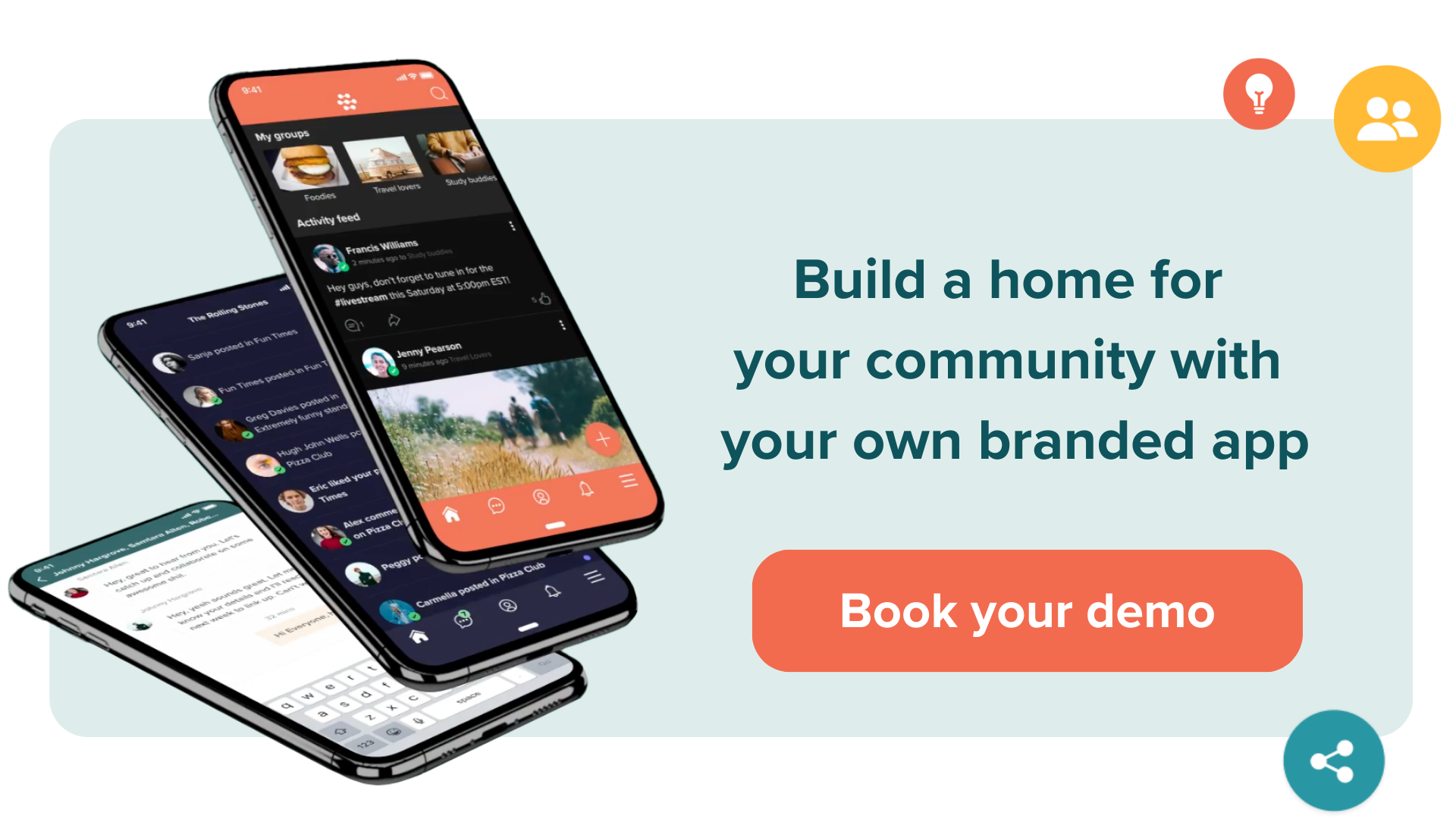Filter by Category
Filter by Category
Contents
Building a membership site enables you to create a digital home for your community, where members can truly thrive. It is a place where like-minded people can come together and support one another to achieve their goals. Whether you are a coach, creator or business, starting a membership site can transform how you engage with your audience and create a recurring revenue stream.
In this blog, we will guide you through the process of building a membership site, from deciding whether it is the right fit for you and your business, to selecting the right platform, all the way through to launching and marketing your membership.
What is a membership site?
Membership websites or apps are dynamic digital platforms that enable hosts to offer exclusive content, services, or products to subscribers, typically in exchange for a recurring fee. They create a gated community where access is reserved for registered members, fostering a sense of exclusivity and community engagement.
The essence of a membership site lies in delivering specialized content and personalized experiences that are not available to non-members, making them a powerful tool for creators, coaches and businesses looking to build a sustainable revenue model.
There are now a range of options available for creating your own membership site, suiting all different budgets, tech-expertise levels and business types. The most popular and affordable option is to use a membership platform builder, like Disciple Media, that will quickly and easily enable you to get set up with your own membership space.
Advantages of a membership model and platform
At Disciple, we’ve worked with hundreds of coaches and creators transitioning to a membership model. The key benefits we repeatedly hear reported are:
- Stable, recurring revenue: Predictable income streams provide financial stability and facilitate long-term planning.
- Scalability: Digital platforms enable you to serve a larger audience without proportionately increasing workload or costs.
- Community building: Engaging with a community fosters customer loyalty and provides valuable feedback for innovation.
- Passive income potential: Automated systems for billing and content delivery can reduce the need for active management, making your business more efficient.
- Control: Building your own membership platform gives you full control of your community, meaning that you can create a space where your community feels safe and your business is set free from risks associated with relying on third parties such as Facebook.
- Building a strong brand: Your own membership business hosted on your own platform boosts your brand recognition in the eyes of your most important customers, as well as increasing the professionalism of your offering.

Steps to create a membership site
Now let’s dive into how to build your own membership site, broken down into 10 important steps:
1. Identify your target audience
- Research and analysis: Begin with detailed market research to understand who your potential members are. Look into demographics, interests, online behavior, and the challenges they face that your membership can address.
- Engagement metrics: Use analytics tools to track which topics or types of content engage your audience the most. This data can inform the creation of targeted content that resonates with your audience.
- Surveys and feedback: Directly ask your audience what they want through surveys, social media polls, or feedback forms. This direct engagement not only provides valuable insights but also makes your audience feel involved in the development of your membership site.
2. Assess your audience structure and readiness for membership
- Segmentation: Break down your broader audience into more manageable segments based on characteristics like age, profession, interests, or engagement level. This allows for more personalized content and marketing strategies.
- Community readiness: Assess the readiness of your audience to form a community. Look for signs of active engagement, such as comments, shares, and discussions among your audience. High engagement levels indicate a strong foundation for a membership model.
- Building a community foundation: If your audience is not yet a community, strategize ways to increase interaction. This could involve creating forums, hosting live Q&A sessions, or offering interactive content to encourage discussions and connections among members.

3. Choose a membership model
- Model exploration: Deep dive into each membership model to understand which best aligns with your goals and your audience’s needs. For example, an ascension model works well for businesses offering progressive levels of learning or services, while a flat-rate model might be better for content-centric sites. Here is a summary of different models to consider:
- Ascension: Guides customers through progressively higher-value offerings, starting from free or low-cost options to premium services, fostering increased trust and investment over time.
- Flat-rate membership: Offers uniform access to services or products for a consistent fee, simplifying marketing and revenue forecasting but may limit customization and revenue potential per customer.
- Tiered membership: Features multiple levels of membership, each with distinct benefits and prices, providing flexibility and choice but increasing complexity in management and marketing.
- Freemium: Provides a basic service for free while offering paid upgrades for premium features, aiming to convert a portion of free users into paying customers through demonstrated value.
- Community-centric: Focuses on the value of community engagement and networking, emphasizing brand loyalty and member retention through active participation and shared experiences.
- Pay-per-use or consumption-based: Charges members based on their actual usage of services or products, offering flexibility and aligning costs with value received but can complicate revenue predictability and billing.
- Hybrid: Combines elements from different models to tailor to specific business needs and customer preferences, offering a balanced value proposition but with increased complexity in implementation and customer communication.
- Customization and flexibility: Consider how flexible each model is to future changes. Your chosen model should allow room for growth and adjustments based on feedback and changing market dynamics. Don’t worry too much though, you can always tweak your model going forwards.
- Pros and cons analysis: Evaluate the advantages and disadvantages of each model in the context of your content, audience, and business objectives. This analysis will guide you in making an informed decision that balances member value with business sustainability.
4. Choose a platform
At the end of this blog we run through some of the main membership platforms available, so keep reading for more help on making your choice!
- Technical requirements: Outline the technical requirements of your membership site, including content hosting needs, payment processing capabilities, community engagement features, and scalability options.
- Platform evaluation: Compare platforms based on criteria such as ease of use, customization options, integration capabilities, and cost. Look into platforms specifically designed for membership sites, like Disciple Media, which offer a suite of tools tailored to these needs.
- Future-proofing: Consider not just your immediate needs but also long-term goals. Choose a platform that can scale with your growth, offering advanced features like analytics, marketing tools, and automation as your membership expands.

5. Build your membership site
- Branding: Craft a compelling brand identity with a unique logo, consistent color scheme, and a distinct voice that clearly communicates your site’s mission, setting you apart and forging a strong connection with your audience. Ensure that your branding is applied consistently across your site.
- Develop a clear and logical structure: Implement a logical and streamlined site architecture that enhances user experience (UX) by making navigation intuitive. This involves organizing content into clearly defined categories, employing a consistent layout, and ensuring that key information and membership benefits are easily accessible within a few clicks. The goal is to minimize user effort in finding content or understanding how to join and benefit from the membership.
- Populate your platform with your content: Carefully curate and regularly update a mix of exclusive content that delivers on your membership’s value proposition, such as educational materials, forums, video tutorials, and interactive tools. This content should not only be high in quality but also targeted to your audience’s needs and interests, encouraging engagement, repeat visits, and word-of-mouth referrals.
- Develop your policies and processes: Establish clear policies and procedures for your membership site, including privacy policies, terms of service, member conduct guidelines, and dispute resolution processes. This ensures transparency, builds trust with your members, and sets the foundation for a well-managed community. Before you launch, it’s well worth spending some time planning out your onboarding process in order to give your first members the best possible start.
- Testing: Conduct comprehensive testing across multiple dimensions, including functionality, usability, compatibility (across different devices, browsers, and operating systems), and security, to identify and fix any issues before launch. This also includes testing the member registration and payment processes to ensure they are seamless and secure, providing a positive first impression and fostering trust in your brand.
6. Create high-quality content
- Content strategy: Develop a comprehensive content strategy that outlines what types of content you’ll offer, how often you’ll publish new content, and how you’ll ensure the content remains engaging and valuable over time.
- Diverse formats: Plan to use a mix of content formats, including written posts, videos, live streams, downloadable resources, and interactive content. This variety caters to different learning styles and keeps the membership experience fresh and engaging.
- Feedback loop for content improvement: Establish mechanisms for gathering member feedback on content, such as regular surveys, comment sections, or direct outreach. Use this feedback to continually refine and improve your content offerings.

7. Pricing your membership
- Value proposition: Clearly define the value proposition of your membership. What makes your membership worth the price? How does it stand out from free content available online or from other membership sites?
- Competitive analysis: Conduct a competitor analysis to understand pricing models in your niche. This research will help you position your membership attractively while ensuring you don’t undervalue or overprice your offering.
- Flexible pricing models: Consider starting with an introductory price to attract early members and plan for future pricing tiers that offer additional value. This approach allows you to cater to a wider audience while also providing an upgrade path for members seeking more.
8. Market your membership site
- Marketing plan: Craft a detailed marketing plan that covers pre-launch buzz, launch promotions, and ongoing marketing efforts. Utilize a combination of email marketing, social media, content marketing, and partnerships to reach potential members.
- Launch strategy: Plan a multi-phased launch strategy that includes a soft launch to gather initial feedback, followed by a full launch. Use limited-time offers to create urgency and exclusivity around your membership launch.
- Member testimonials and case studies: As your membership grows, collect testimonials and case studies from satisfied members. These can be powerful tools for demonstrating the value of your membership to prospective members.
9. Launching your membership site
- Soft launch: Begin with a soft launch to a select group of users. This allows you to gather feedback and make necessary adjustments before the full launch.
- Full launch: Execute your full launch with a clear message and value proposition. Utilize all your marketing channels to reach your target audience, emphasizing the benefits and unique features of your membership.
- Launch pricing: It is well worth offering a discount to founding members to create urgency and get people in the door when you first launch. Limit this offer by setting a specific time period (eg first 30 days) or a cap on the number of members who will be eligible (eg first 100 members).
- Monitoring and adjusting: Keep a close eye on analytics during and after the launch. Be prepared to adjust your strategy based on member behavior, feedback, and enrollment rates.
10. Gathering feedback and improving
- Continuous feedback mechanism: Implement a continuous feedback mechanism through surveys, suggestion threads, or direct communication channels. Encourage members to share their experiences and suggestions for improvement.
- Iterative improvements: Use the feedback to make iterative improvements to your membership site. This includes refining content, adding new features, and adjusting pricing or membership tiers as needed.
- Member involvement: Involve members in the improvement process by sharing updates on changes made based on their feedback. This fosters a sense of community and shows that you value their input.
Best membership platforms
When choosing a platform for your membership site, it’s crucial to select one that aligns with your specific needs, goals, and the level of technical support you require. Here are some of the top contenders in the membership builder space:
- Disciple Media: Tailored for creators and coaches, Disciple Media stands out for its ability to create deeply engaging and branded membership apps on web, Android and iOS. It offers extensive customization, a wide range of engagement tools, and robust content management capabilities, making it ideal for those looking to build a strong community around their brand. The platform is easy-to-use, makes monetization a cinch and has the major benefit of being mobile-first.
- Mighty Networks: This platform excels at bringing people together, offering great tools for creating courses, groups, and membership subscriptions within your community. However, creating a mobile app on Mighty will cost you double what Disciple charges and it’s crowded UI can be confusing to use.
- Kajabi: Perfect for those focused on educational content, Kajabi integrates course creation, marketing, and membership management tools. Its comprehensive suite of features supports video hosting, marketing automation, and website building, but it lacks strong community features.
- MemberPress: A WordPress plugin that offers ease of use for those already familiar with the WordPress ecosystem. It provides powerful access rules, drip content features, and integration with many third-party tools for email marketing and payment gateways.
- Teachable: With a focus on courses and coaching services, Teachable offers an intuitive interface for course creation, alongside tools for email marketing, analytics, and a customizable checkout experience. Like Kajabi, Teachable lacks community tools.
Each platform has its strengths, so consider your content type, engagement strategies, technical expertise, and budget when making a decision.
Conclusion
Building a successful membership website combines understanding your audience, choosing the right model and platform, and continuously delivering value through high-quality content and engagement. With the right strategy and tools, your membership site can become a thriving community that supports your business goals.
FAQs
How do I decide which membership model is right for my business?
Consider your content, audience preferences, and business goals. Analyze different models for their scalability, engagement potential, and revenue opportunities. A trial period or soft launch can also provide insights into what works best for your audience.
Can I change my membership platform later?
Yes, but it can be complex and time-consuming. It’s best to carefully consider your long-term needs before choosing a platform to minimize the need for migration in the future.
How often should I update my content?
Consistency is key. Determine a content schedule that is sustainable for you and meets your members’ expectations—whether that’s weekly, bi-weekly, or monthly. Regular updates keep your community engaged and provide continuous value.
What are the most effective marketing strategies for a membership site?
Utilize a mix of content marketing, social media engagement, email marketing, and SEO. Leveraging partnerships and member testimonials can also be powerful in attracting new members.
How do I set the price for my membership?
Consider the value you provide, your costs, and competitor pricing. Offering tiered pricing can accommodate different levels of engagement and investment from your members.
What’s the best way to gather feedback from members?
Implement regular surveys, encourage comments and discussions within your platform, and create an open channel for feedback through email or direct messaging. Active solicitation of feedback and showing that you act on it can enhance member satisfaction and retention.
See how a Disciple community
can fit your business needs
See how a Disciple community can fit your business needs
Related Articles
18 min read
How To Build Your Online Community From Scratch
Wondering how to create a community? How to turn your social media presence into a thriving online community? …
8 min read
How the Best Businesses Build Brand Communities (+Examples)
No matter the name of your brand, the industry you operate in, the products you make or the …
9 min read






